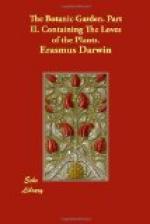[Caffia. l. 413. Ten males, one female. The seeds are black, the stamens gold-colour. This is one of the American fruits, which are annually thrown on the coasts of Norway; and are frequently in so recent a state as to vegetate, when properly taken care of, the fruit of the anacardium, cashew-nut; of cucurbita lagenaria, bottlegourd; of the mimosa scandens, cocoons; of the piscidia erythrina, logwood-tree; and cocoa-nuts are enumerated by Dr. Tonning. (Amaen. Acad. 149.) amongst these emigrant seeds. The fact is truly wonderful, and cannot be accounted for but by the existence of under currents in the depths of the ocean; or from vortexes of water passing from one country to another through caverns of the earth.
Sir Hans Sloane has given an account of four kinds of seeds, which are frequently thrown by the sea upon the coasts of the islands of the northern parts of Scotland. Phil. Trans. abridged, Vol. III. p. 540. which seeds are natives of the West Indies, and seem to be brought thither by the gulf-stream described below. One of these is called, by Sir H. Sloane, Phaseolus maximus perennis, which is often also thrown on the coast of Kerry in Ireland; another is called, in Jamaica, Horse-eye-bean; and a third is called Niker in Jamaica. He adds, that the Lenticula marina, or Sargosso, grows on the rocks about Jamaica, is carried by the winds and current towards the coast of Florida, and thence into the North-American ocean, where it lies very thick on the surface of the sea.
Thus a rapid current passes from the gulf of Florida to the N.E. along the coast of North-America, known to seamen by the name of the GULF-STREAM. A chart of this was published by Dr. Francklin in 1768, from the information principally of Capt. Folger. This was confirmed by the ingenious experiments of Dr. Blagden, published in 1781, who found that the water of the Gulf-stream was from six to eleven degrees warmer than the water of the sea through which it ran; which must have been occasioned by its being brought from a hotter climate. He ascribes the origin of this current to the power of the trade-winds, which, blowing always in the same direction, carry the waters of the Atlantic ocean to the westward, till they are stopped by the opposing continent on the west of the Gulf of Mexico, and are thus accumulated there, and run down the Gulf of Florida. Philos. Trans. V. 71, p. 335. Governor Pownal has given an elegant map of this Gulf-stream, tracing it from the Gulf of Florida northward as far as Cape Sable in Nova Scotia, and then across the Atlantic ocean to the coast of Africa between the Canary-islands and Senegal, increasing in breadth, as it runs, till it occupies five or six degrees of latitude. The Governor likewise ascribes this current to the force of the trade-winds protruding the waters westward, till they are opposed by the continent, and accumulated in the Gulf of Mexico. He very ingeniously observes, that a great eddy must be produced




